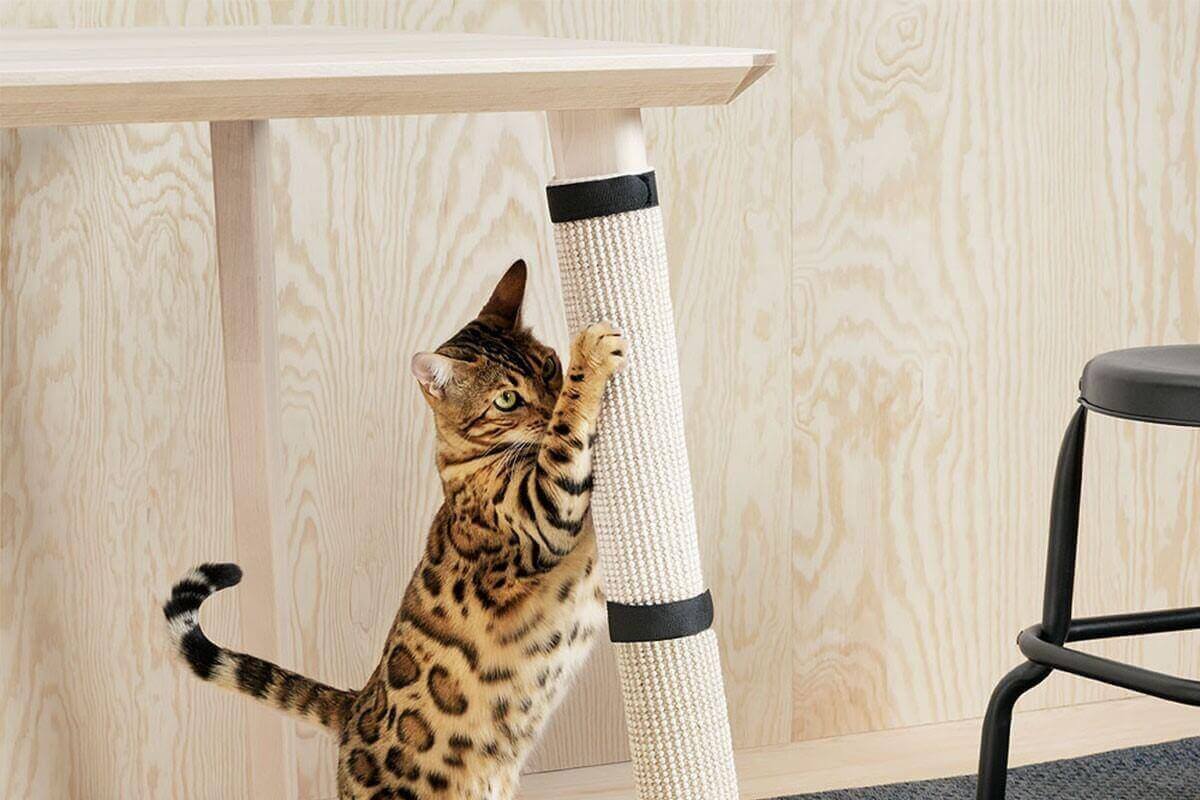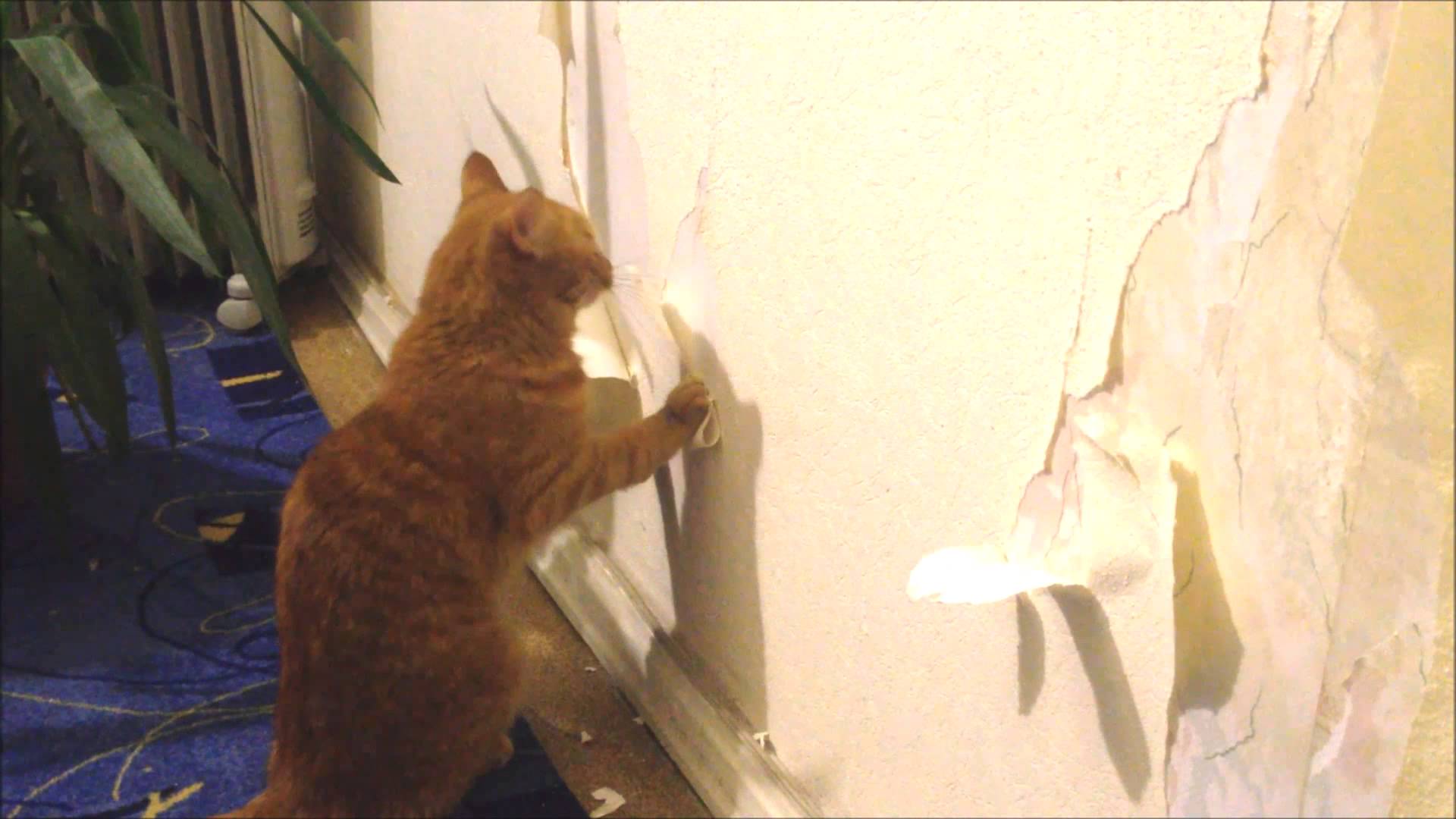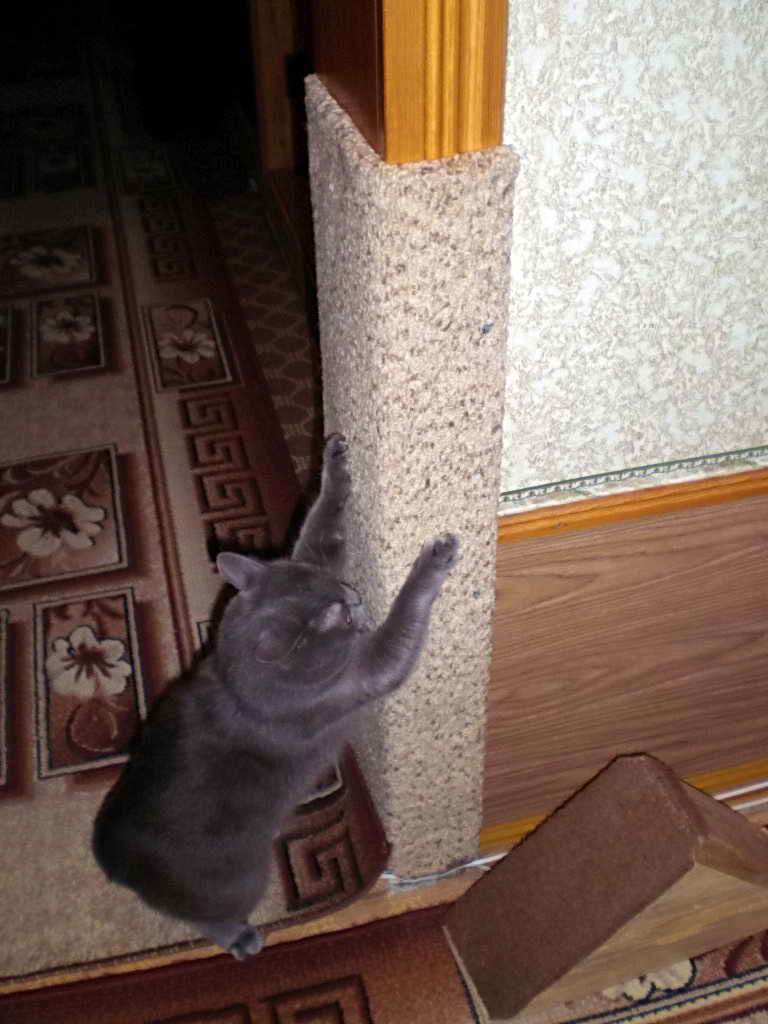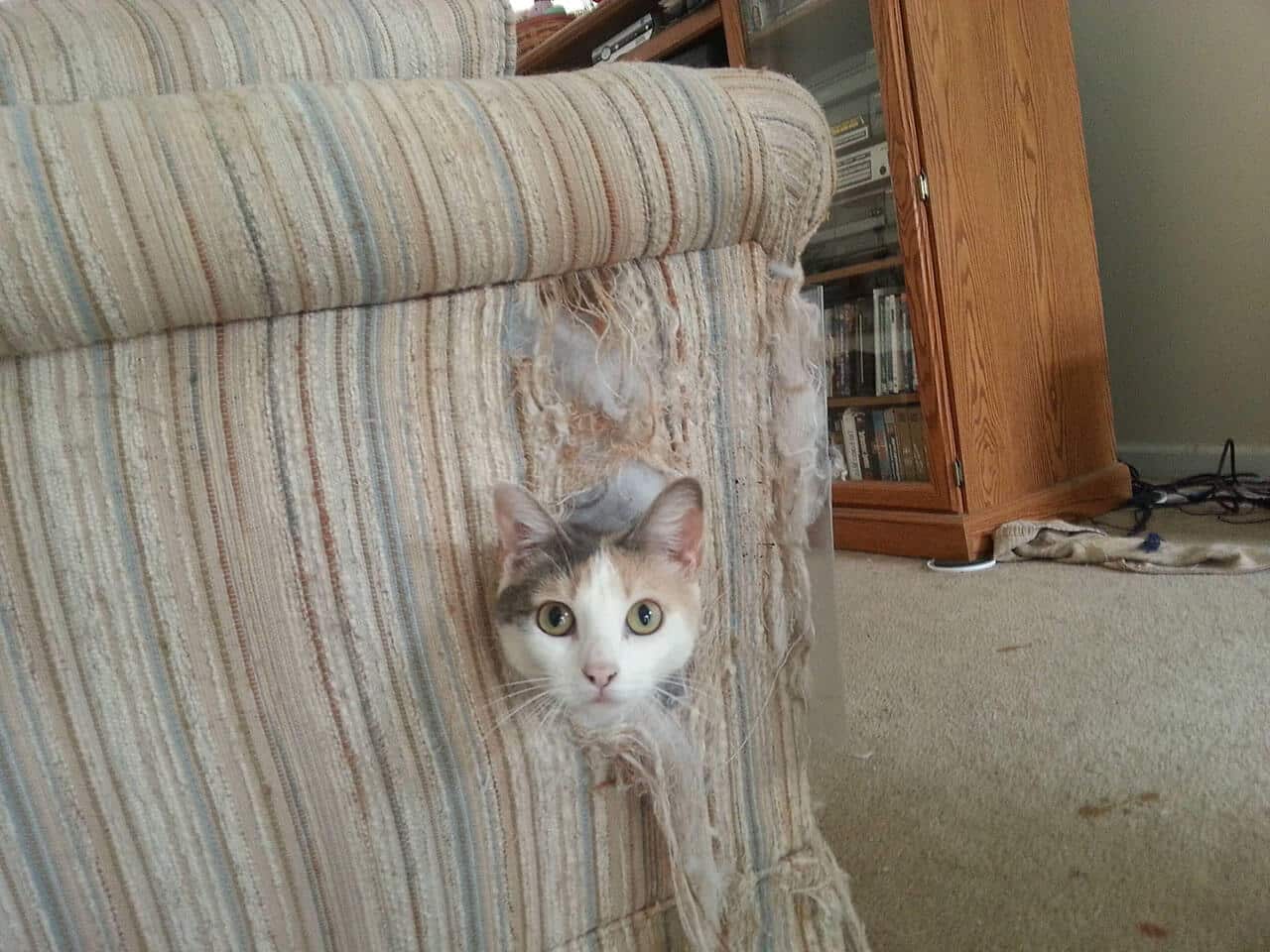How to stop a cat from scratching wallpaper and furniture
When a kitten appears in the house - a small fluffy lump, he immediately becomes a favorite of the whole family, which treats him with adoration. His every movement causes universal delight, and even the first pranks, such a funny point of tiny claws on his favorite sofa, are perceived with tenderness.

However, a little time will pass, and furniture damaged by claws will no longer be taken for granted. As well as expensive wallpaper torn apart by a tailed "bully" house.
Why does the cat tear furniture and scratch the wallpaper
Seeing the ruin that the cat is arranging in the apartment, some owners, instead of thinking about how to wean the cat from tearing the wallpaper, begin to severely punish the animal, not even suspecting that the bulk of the blame lies with themselves.

Why this happens, it is important to understand in order to prevent further "forays" on furniture and wallpaper. These problems rarely arise for those who live “on the ground”: in private households, cottages, dachas, where the animal can walk freely and independently choose the place where it can sharpen its claws.

For those living in apartments, the problem of how to wean a cat from scratching wallpaper is very acute. According to experts, the sources of such behavior can be physiological, behavioral and psychological problems, which, however, can be solved.

Physiology
Although a cat has lived next to humans for many millennia, it remains a predator in its essence. Sharp claws are a prerequisite for being ready to attack, hunt or defend yourself. And if the owner did not provide personal space for his pet, creating conditions for the claws to always be in order, he will certainly be punished for his inattention with torn wallpaper.

In addition, there are purely physiological problems that must be taken into account when raising a cat:
- sharpening claws is a natural cat's need - this way they get rid of the interfering layer of overgrown claws;
- in such an unusual way they "mark" the boundaries of their territory;
- this procedure is combined with kneading the muscles that provide flexibility to the cat.

Psychological problems
Unfortunately, not everything can be explained and justified by physiology. Sometimes psychological problems arise that are associated with the emotional state of the furry friend. These animals are characterized by a rich palette of feelings and emotions: from joyful purring to angry hiss and vigorous damage to furniture and wallpaper.

Moreover, if the cat is angry, he, despite the menacing shouts of the owners, will continue his "dirty deed" with even greater fury: in this way he relieves stress, the appearance of which has a variety of reasons:
- one of them is jealousy - cats are rarely indifferent to the need to share the love and attention of the owner with someone else, be it the owner's dog or the owner's child;
- anxiety associated with the appearance of an intruder on a cat's personal space or territory.

Behavioral Causes
One of the reasons for the ugly behavior is the lack of attention from the owner. Poor grooming and lack of upbringing can also contribute to the violation of feline discipline. Some believe that a cat that "walks by itself" does not require any upbringing, which is not true.

Its absence is necessarily reflected in the habits of the animal. A small kitten does not understand what can and cannot be done in an apartment - it must be "explained" by available methods, without punishing the baby.

If initially the owner did not pay due attention to this issue, it will be quite difficult to wean the cat from tearing the wallpaper, and it will take a lot of time.
How to stop a cat from tearing up everything
Despite the complexity of the problem, there are many ways to solve it. One of them, which some owners use, is the purchase of anti-scratch claws. They will be able to protect furniture from injuries caused by animals.

However, do not forget that they can be used for a short period of time, as these linings deprive the cat of stability. It is difficult for the cat to move with them, because the pads do not allow the claws to be drawn in, that is, they deprive the paws of their natural position.
Of course, this accessory does not cause obvious physical injuries, but it causes a lot of inconvenience to the animal, makes it restless, and causes pain during movement.
Attention! It is worth considering whether it is necessary to torment the cat like that, if there are several gentle methods that will help him get rid of the bad habit.
Scratching post
One of the safest and most useful ways is to purchase a scratching post - a simple and safe accessory. Home craftsmen can make it on their own, since the design is simple and straightforward. It is a piece of plank that is tied to the hardest-hit side of the sofa and is easily accessible.

The scratching post is a compact product that does not take up much space and allows the pet to sharpen its nails in a timely manner and not harm the interior of the apartment.
Important! The size of the product should allow the animal to fully extend in length, regardless of the place of attachment and shape.

Do not hope that the kitten will immediately run to a new object, and all problems will be removed. However, it is important to understand that you will have to be patient so that the baby gets used to the new accessory and turns his attention from the master's wallpaper to the scratching post. To do this, you can:
- direct it to the device;
- hold the cat's paws along the surface so that it catches its claw on it.
Claw trimming
Another option for the ability to wean the cat from scratching everything is to remove long claws by cutting them. This will require attention, care and accuracy from the owner. Before proceeding with this procedure, you must familiarize yourself with the procedure for its implementation. Claws must be cut very carefully so as not to hurt your pet.

If a decision is made to trim the cat's claws, it is better to go to a veterinary clinic, where the procedure will be carried out quickly and painlessly, in compliance with all veterinary standards, by specialists.
Note! Some cat owners want to completely remove the claws. Such an operation is considered inhumane and can not only cause psychological trauma, but also cripple him, make him, in fact, disabled.
Make the surface unattractive
There are quite safe ways to combat a cat's desire to sharpen its claws on a sofa or wallpaper, one of which is to change the surface structure, which will become unpleasant for the cat.

This can be done in several ways:
- use the tape "Sticky Paws", which can be purchased at veterinary pharmacies and pet stores;
- some use fine sandpaper, as well as pieces of old suede or artificial leather, on narrow sheets of paper;
- during the next renovation, use materials that they do not like to decorate the places most susceptible to destruction by cats: decorative plaster, vinyl and glass wallpaper, laminate, tiles or PVC panels.
Scare away with smell
If, despite the actions taken, the cat stubbornly continues to spoil the upholstered furniture and wallpaper, you can try to wean it from this bad habit, knowing that there are scents that the cat's scent categorically does not accept.

And if so, then you need to know the best way to smear the furniture so that the cat does not scrub the home environment. Experienced owners offer the following options:
- purchase drugs specially designed for this case in a pet store and apply to the most suffering areas;
- essential oils of citrus fruits, which are categorically intolerant of the cat family or dried peel of fruits, will help;
- they have no love for the smells of spices, which can be hung in small bags near the places where the cat commits its "illegal actions".
Double sided tape
If the answer to the question of how to wean a cat from tearing wallpaper has not been obtained in practice, you can try another option, fixing double-sided tape on the most favorite places for damage. The sticky side of it, where the paw falls, is unlikely to be pleasant for a furry bully.

He will soon stop "raids" on the owner's furniture and will not spoil the wallpaper.
Water use
It is no secret that cats, for the most part, are not lovers of water procedures. If, despite all the efforts of the owners, the pet continues to rob, you can use a spray bottle filled with water. If you spray it directly on his face, then the desire to misbehave will immediately disappear.

It is better if you spray with liquid at the time of preparation of the "crime" or in its process. The punishment after it has been committed will not be understood by the animal.
What to do if all else fails
To solve the problem, if it cannot be solved in other ways, you can use another option, which involves unexpected loud sounds to scare off.

Such a factor can be:
- loud disgruntled shout: "You can't!", "Fight!";
- the sound of a rattle bought in a store;
- use a homemade "scarer" built from a tin can with a handful of coins.

Some people advise using inflated balloons to block the way to the forbidden place. However, not everyone approves of this method, so the choice is up to the owner.
How to avoid mistakes
Many, having a little kitten, perceive it as a living toy, while imagining that its content will not cause any problems.But when the kid starts to misbehave: he spoils the wallpaper with his claws or "combs" the upholstered furniture, they begin to punish the fuzzy, who, oddly enough, day by day becomes more and more naughty and causes more and more damage to the environment.

If someone has such a perception of a cat, it is better not to start it at all. From the first days of his life, a tailed handsome man needs to be educated, and if the time for education is missed, then reeducate. To do this, be patient, do not get angry and do not punish the crumb.

In order not to grow up from a small cat to a big egoist and not to turn into his slave, you should familiarize yourself with the method of proper handling of cats. The owner should help the baby to get used to order, calmly and purposefully.

In addition, it is worth familiarizing yourself with the experience of other owners who highlight the most significant mistakes in the upbringing of four-legged and not repeat them:
- an animal cannot be punished;
- it is worth abandoning self-cutting nails, and contacting a veterinarian for help;
- it is better to keep the old scratching post - the new one may not like the animal, but it is better to place it at the front door or near the bed;
- if the scratching post still needs to be replaced, then next to it you need to place objects that will distract the attention of the fluffy from his destructive actions.

Rules for caring for a cat or cat
In order for communication with a little cat to bring mutual satisfaction, it is worth knowing the rules of caring for a four-legged, which will not require much strength, but love and patience.

- The first and most important condition is personal space, a place for the animal: it can be a house or bedding on which it will sit and sleep. In this case, one must not forget to shake out dust and wool from it, and also periodically wash it.
- Food should be varied, nutrition - balanced.
- If a cat lives in an apartment, from the first days of his life he needs to be trained to use the litter box.
- The coat requires care, especially if the cat is of the long-haired breed.

These simple tips will help you grow an affectionate, obedient and neat animal that will thank you for taking care of its owner with a gentle purr.
Video: weaning a cat from scratching furniture is possible!





